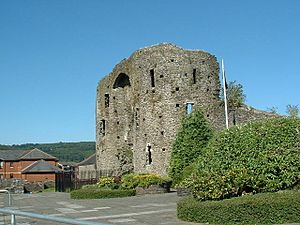Neath Castle facts for kids
Neath Castle (which is Castell Nedd in Welsh) is an old Norman castle right in the middle of Neath, Wales. People think it was started by Robert, Earl of Gloucester, who was an important lord, sometime between 1114 and 1130. It's also sometimes called "Granville's Castle" because Richard I de Grenville, another lord of Neath, is also thought to have built it. The town of Neath even gets its Welsh name, "Castell-nedd," from this very castle!
Contents
The Castle's Story: A Timeline
Neath Castle has a long and exciting history, full of changes and battles. Let's explore how it came to be and what happened to it over the years.
The First Castle: A Wooden Fort
The very first castle in Neath wasn't where the stone one is today. It was a wooden fort built on a mound of earth, known as a motte and bailey castle. This first castle was located west of the river, near an old Roman fort called Nidum. When Richard I de Grenville decided to build Neath Abbey nearby, he left this first wooden castle. The monks might have even used its materials to help build their abbey.
Building the Stone Castle
The second castle, which is the one we see parts of today, was built on the other side of the river. This new castle was made of stone and was first mentioned in records around 1183. Soon after, a man named William de Cogan became its constable, which means he was in charge of the castle. This stone castle was built by Gilbert de Clare, 5th Earl of Gloucester.
Battles and Rebuilding
During the 1200s, Neath Castle was a strong Norman base. Because of this, it was often attacked by the Welsh. A famous Welsh leader named Llywelyn the Great captured the castle in 1231. He had help from a local Welsh lord named Morgan Gam. After this, the castle was greatly rebuilt by Richard de Clare, 6th Earl of Gloucester, who was Gilbert's son.
In 1321, the castle was attacked and destroyed again. This time, it was by Humphrey de Bohun, 4th Earl of Hereford, during a rebellion against King Edward II of England. The castle's owner at the time, Hugh Despenser the Younger, rebuilt it. He might have added a large gatehouse, which is a strong entrance building.
Later Years and What Remains Today
In 1376, Roger Kyngot was the constable of the castle. The castle was rebuilt in stone again in 1377. This is probably when the impressive great gatehouse, which is the main part of the castle still standing today, was built.
Neath Castle was used until the 1600s. Since the 1700s, it has been a place for people in the town to relax and enjoy. The old job of "Constable of Neath Castle" was held by Sir Humphrey Mackworth starting in 1703. Eventually, this title became part of the job of the Mayor of Neath.
What is left of Neath Castle today is considered a very important historical building, known as a Grade II* listed building.
Images for kids








